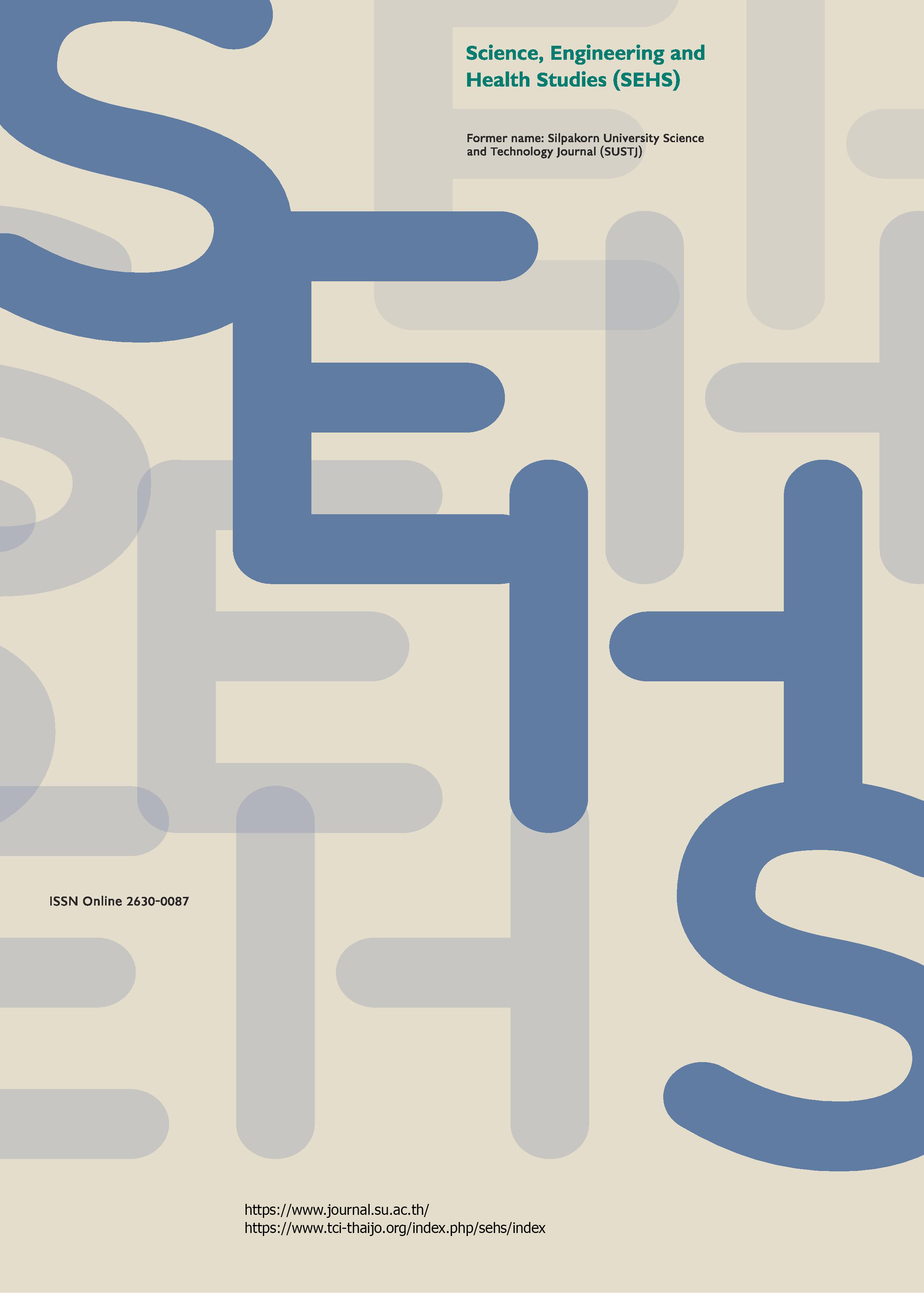Development of lutein-loaded niosomes for topical delivery
Main Article Content
Abstract
Lutein (Lut), a fat-soluble xanthophyll compound, is a derivative of carotenoids. It has several biological activities such as antioxidant, antimicrobial, and anti-inflammatory. In particular, the antioxidant activities of Lut are widely used as primary skin protection to alleviate oxidative injury caused by free radicals from sunlight. However, the structure of Lut is easy to decompose and is unstable to exposure by various stimuli such as pH, temperature, oxidation reaction, and light. Therefore, this study aimed to formulate niosomes to encapsulate Lut. Niosomes were prepared using the thin film hydration method. The droplet size, polydispersity index, zeta potential, encapsulation efficiency, and loading capacity were investigated. Moreover, photodegradation, the effect of limonene as a skin enhancer on skin permeation, and antioxidant activity were examined. The results revealed that the niosome formulation for Lut delivery contained Span20, cholesterol, and oleic acid at the ratio of 2:1:1. The niosomes with limonene exhibited the highest skin penetration compared to the niosomes without limonene and Lut suspension. The formulation with and without limonene as a component exhibited the highest antioxidant activity. In conclusion, encapsulating Lut in niosomes could facilitate its penetration into the skin as well as enhance antioxidant properties, which can be applied and further developed into cosmeceuticals.
Downloads
Article Details

This work is licensed under a Creative Commons Attribution-NonCommercial-NoDerivatives 4.0 International License.
References
Abdelbary, A. A., and AbouGhaly, M. H. H. (2015). Design and optimization of topical methotrexate loaded niosomes for enhanced management of psoriasis: Application of Box-Behnken design, in-vitro evaluation and in-vivo skin deposition study. International Journal of Pharmaceutics, 485(1–2), 235–243.
Balakrishnan, P., Shanmugam, S., Lee, W. S., Lee, W. M., Kim, J. O., Oh, D. H., Kim, D.-D., Kim, J. S. Yoo, B. K., Choi, H.-G., Woo, J. S., and Yong, C. S. (2009). Formulation and in vitro assessment of minoxidil niosomes for enhanced skin delivery. International Journal of Pharmaceutics, 377(1–2), 1–8.
Bartelds, R., Nematollahi, M. H., Pols, T., Stuart, M. C. A., Pardakhty, A., Asadikaram, G., and Poolman, B. (2018). Niosomes, an alternative for liposomal delivery. PLoS One, 13(4), e0194179.
Chaudhary, A., Gupta, M., Kumari, K., and Sachan, A. K. (2022). Preparation and evaluation of niosomes for the delivery of antioxidant to the skin for antiaging purpose. Asian Journal of Pharmaceutical Research and Development, 10(3), 34–39.
Ge, X., Wei, M., He, S., and Yuan, W.-E. (2019). Advances of non-ionic surfactant vesicles (niosomes) and their application in drug delivery. Pharmaceutics, 11(2), 55.
Heinrich, U., Gärtner, C., Wiebusch, M., Eichler, O., Sies, H., Tronnier, H., and Stahl, W. (2003). Supplementation with β-carotene or a similar amount of mixed carotenoids protects humans from UV-induced erythema. The Journal of Nutrition, 133(1), 98-101.
Hmingthansanga, V., Singh, N., Banerjee, S., Manickam, S., Velayutham, R., and Natesan, S. (2022). Improved topical drug delivery: Role of permeation enhancers and advanced approaches. Pharmaceutics, 14(12), 2818.
Ioele, G., Tavano, L., De Luca, M., Ragno, G., Picci, N., and Muzzalupo, R. (2015). Photostability and ex-vivo permeation studies on diclofenac in topical niosomal formulations. International Journal of Pharmaceutics, 494(1), 490–497.
Junyaprasert, V. B., Singhsa, P., Suksiriworapong, J., and Chantasart, D. (2012). Physicochemical properties and skin permeation of Span 60/Tween 60 niosomes of ellagic acid. International Journal of Pharmaceutics, 423(2), 303–311.
Jiao, Y., Li, D., Liu, C., Chang, Y., Song, J., and Xiao, Y. (2018). Polypeptide – decorated nanoliposomes as novel delivery systems for lutein. RSC Advances, 8(55), 31372–31381.
Madaan, T., Choudhary, A. N., Gyenwalee, S., Thomas, S., Mishra, H., Tariq, M., Vohora, D., and Talegaonkar, S. (2017). Lutein, a versatile phyto-nutraceutical: An insight on pharmacology, therapeutic indications, challenges and recent advances in drug delivery. PharmaNutrition, 5(2), 64–75.
Mitra, S., Rauf, A., Tareq, A. M., Jahan, S., Emran, T. B., Shahriar, T. G., Dhama, K., Alhumaydhi, F. A., Aljohani, A. S. M., Rebezov, M., Uddin, M. S., Jeandet, P., Shah, Z. A., Shariati. M. A., and Rengasamy, K. R. (2021). Potential health benefits of carotenoid lutein: An updated review. Food and Chemical Toxicology, 154, 112328.
Moammeri, A., Chegeni, M. M., Sahrayi, H., Ghafelehbashi, R., Memarzadeh, F., Mansouri, A., Akbarzadeh, I., Abtahi, M. S., Hejabi, F., and Ren, Q. (2023). Current advances in niosomes applications for drug delivery and cancer treatment. Materials Today Bio, 23, 100837.
Muzzalupo, R., and Tavano, L. (2015). Niosomal drug delivery for transdermal targeting: Recent advances. Research and Reports in Transdermal Drug Delivery, 4, 23–33.
Puras, G., Mashal, M., Zárate, J., Agirre, M., Ojeda, E., Grijalvo, S., Eritja, R., Diaz-Tahoces, A., Navarrette, G. M., Avilés-Trigueros, M., Fernández, E., and Pedraz, J. L. (2014). A novel cationic niosome formulation for gene delivery to the retina. Journal of Controlled Release, 174, 27–36.
Sguizzato, M., Pepe, A., Baldisserotto, A., Barbari, R., Montesi, L., Drechsler, M., Mariani, P., and Cortesi, R. (2023). Niosomes for topical application of antioxidant molecules: Design and in vitro behavior. Gels, 9(2), 107.
Singpanna, K., Pornpitchanarong, C., Patrojanasophon, P., Rojanarata, T., Ngawhirunpat, T., Pamornpathomkul, B., and Opanasopit, P. (2023). Gold nanoparticles for enhanced skin permeation of a protein drug. Natural and Life Sciences Communications, 22(4), e2023065.
Yu, Y.-Q., Yang, X., Wu, X.-F., and Fan, Y.-B. (2021). Enhancing permeation of drug molecules across the skin via delivery in nanocarriers: Novel strategies for effective transdermal applications. Frontiers in Bioengineering and Biotechnology, 9, 646554.
Zhang, Y., Kong, L., and Tan, L. (2022). Effectiveness of nanoscale delivery systems on improving the bioavailability of lutein in rodent models: A systematic review. Critical Reviews in Food Science and Nutrition, 62(9), 2375–2390.

